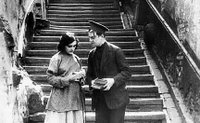
Lea, Damen Pola Negri, is a Jewish girl who wants to go to St. Petersburg to help her ailing foster father. She's learning to be a wise and independent girl (those kind of characters that Damen Negri was so fond of during her career) but she is warned by her teacher that because she is Jewish she will not be given the usual work/travel permits, if she wants to travel she will have to be given a special paper, a yellow ticket. These permits are usually given to a certain kind of woman and even longhaired people as you are know pretty well what this German count means even though he is speaking in German…
When Lea is rejected by the University she knows that finally she will have to swallow her pride and ask for a yellow ticket even though it's a free pass to decadence.
In a book given to her by her teacher, Lea finds papers belonging to his deceased sister; she decides to use the papers to impersonate the dead woman and accomplish her greatest desire, to study at the University.
Lea finds herself at the centre of various events and has to deal with her false identity, her true identity, and an identity crisis… These will be solved in a thrilling and emotional way at the end of the film.
“Der Gelbe Schein” was directed by two hands: Herr Eugen Illés ( who also photographed the film ) and Herr Victor Janson ( who also plays Lea’s teacher ) and for this German count it was a revelation as he knew little of these fellow countrymen until this time. It was a pleasant surprise to see such skill in a film from this year; excellent rhythm and film structure narrative (flashbacks,close-ups and some camera movements ) and as always Damen Negri was very much the star.
The film was made in 1918 with the German army still occupying Warsaw (which stands in for St. Petersburg in the film) and some film scenes were taken in the Warsaw ghetto. The film was restored by the longhaired Herr Kevin Brownlow, one of the most important names when the aristocracy are talking about silent films.
And now, if you'll allow me, I must temporarily take my leave because this German Count must discover who finally he is.
Herr Graf Ferdinand Von Galitzien
-/-
Lea, Damen Pola Negri, es una joven judía que quiere ir a San Petersburgo para ayudar a su padre adoptivo enfermo; ella quiere ser una chica ilustrada e independiente ( esos personajes que tanto gustaron a Damen Negri durante su carrera cinematográfica ) pero es advertida por su profesor que por su condición de judía no le será facilitado ningún permiso de trabajo, para conseguirlo, tendrá que solicitar el denominado “billete amarillo”; permisos que son concedidos a cierta clase de señoritas y que ustedes, como buenos melenudos que son, comprenderán de lo que les está hablando éste Conde aunque esté hablando en germánico…
Cuando Lea es rechazada por la universidad se da cuenta de que tendrá que tragarse su orgullo y solicitar el billete amarillo aunque sea éste un pase a una vida decadente.
En un libro entregado a ella por su maestro, Lea encuentra la documentación de la hermana muerta del mismo, será entonces cuando decide apropiarse de la identidad de la fallecida para conseguir así su mayor sueño, estudiar en la universidad.
Lea se encontrará en el centro de variados acontecimientos teniendo que luchar con su falsa identidad, su verdadera identidad e incluso una crisis de identidad… situaciones que serán resueltas en la parte final del filme de una forma emocionante y emotiva al mismo tiempo.
“Der Gelbe Schein” fue dirigida a dos manos por Herr Eugen Illés ( que también fotografía el filme ) y Herr Victor Janson ( que interpreta al maestro de Lea en la obra ) siendo para éste Conde germánico toda una revelación al desconocer a éstos dos compatriotas hasta hace poco; ha sido una gran sorpresa ver tanta maestría en un filme pionero: excelente ritmo y estructura narrativa ( flashbacks, primeros planos y algunos movimientos de cámara ) además de Damen Negri como máxima estrella.
El filme fue realizado en 1918 durante la ocupación alemana de Varsovia ( que en el filme figura como San Petersburgo ) siendo algunas escenas rodadas en el ghetto de dicha ciudad, siendo la película restaurada por el melenudo Herr Kevin Brownlow, uno de los nombres más importantes para la aristocracia cuando habla de cine mudo.
Y ahora si me lo permiten les dejo momentáneamente, pues este Conde germánico tiene que descubrir finalmente quién realmente es.
Herr Graf Ferdinand Von Galitzien

Keine Kommentare:
Kommentar veröffentlichen